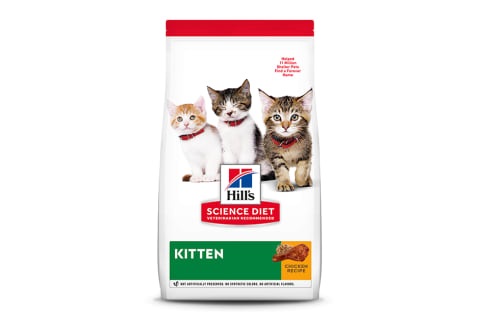Do You Have A Natural Disaster Plan In Place For Your Pet? Here’s Your Guide

Whether it’s happening outside your doorstep or populating your news feed, it’s clear we live in a quickly changing environment, where disasters and emergencies are (unfortunately) more commonplace. In fact, the number of disasters costing over a billion dollars has increased to 13 per year compared to three in the 1980s. The need for preparation has never been greater—for us, and our pets.
Our pets: The silent victims of disasters.
Here’s the thing about disasters and emergencies: They often strike without warning, forcing us to act quickly. But what if our pet is hiding and we don’t have time to find them? What if they’re lost outdoors? All too often, our pets are the silent victims of natural disasters. Hurricane Katrina is a prime example, leaving at least 88,700 pets unaccounted for. And disasters like tornadoes, earthquakes, and wildfires are infamous for leaving shelters overwhelmed with displaced pets.
Thankfully, there are impactful programs in place that we can learn from and support, like Hill’s Disaster Relief Network. Established in 2013, this network has provided more than 400,000 pounds of food in response to more than 100 disasters nationwide. But at an individual level, how can we protect our pet from a wild, unpredictable world? As it turns out, making small preparations now can make all the difference later.

Your step-by-step guide to a natural disaster plan.
If a disaster strikes, the last thing you want is to be scrambling around last minute to help your pet. A natural disaster plan means making preparations ahead of time to ensure that all members of the family, pets included, are ready for anything. As experts in disaster relief, we turned to Hill’s Pet Nutrition to understand what it takes to make a plan, and we’re sharing the step-by-step with you!
1. Use a microchip and/or collar I.D.
Microchipping can help increase the odds of getting a lost cat or dog back. Whether a daunting storm is moving in, or someone leaves the back gate open, we’ll always feel grateful we took this simple step. But even with a microchip, make sure your pet has a collar I.D. with up-to-date contact information.
2. Know your pet’s hiding spots.
When our pets are scared or feel threatened, they often respond by hiding. But when disasters hit, time is of the essence. Know exactly where your pet goes when they’re scared (think thunder and fireworks), so that you can evacuate faster if need be.
3. Determine a pet-friendly place in case of evacuation.
Wildfires, hurricanes, floods—evacuation is sometimes the only way to guarantee safety. Make sure you’ve determined a pet-friendly place where you can evacuate to. Have a just-in-case conversation with a friend or family member who loves your pet and cares about their safety as much as you do.
4. Carry a picture of your pet in case you get separated.
As they say, prepare for the worst but hope for the best. In the event you’re ever separated from your pet, keep a picture of them handy. This can help rescuers identify and return your furry friend if they’ve gone missing. We’ll guess there’s no shortage of pictures on your phone, but throw a hard copy in your wallet just in case.
5. Keep a pet carrier or crate on hand.
When our pets are scared, they’re prone to run or react. Stow a pet carrier or crate to help you transport your pet more comfortably and safely. Pro tip: Line your carrier with a quick-absorbing pad in advance so you don’t have to worry about accidents.
6. Build an emergency kit for your pet.
Expecting the unexpected is smart pet parenting, and an emergency kit is the essence of preparedness. According to Hill’s Pet Nutrition, your emergency kit should include:
- Basic first aid supplies
- A 3-day supply of bottled water and the pet’s preferred food, held in a waterproof container. Tip! Put the expiration date on the food container so you know when it needs a refresh
- Safety harness and leash
- Waste clean-up supplies
- Medications and a copy of the pet’s most recent medical records
- List of veterinarians and local pet care organizations
- List of the pet’s feeding routine and any behavioral issues
- Comfort items, such as a blanket or favorite toy, to help keep the pet calm and comfortable
Ready for anything.
We want our four-legged companion to stay happy and healthy in the long run. That means best-in-class nutrition, plenty of activity, and as much love as humanly possible… But also thinking ahead for their safety.
From the day-to-day to the unexpected, Hill’s Pet Nutrition is on a mission to provide pets with the very best care. That includes their science-led nutrition, but also their Disaster Relief Network. Partnering with shelters, veterinary hospitals, nonprofits, and governmental organizations, they can help keep pets and shelter animals fed—even when the unthinkable happens.
So when should you start preparing for an emergency? There’s only one answer: right now! Putting a plan together isn’t excessive, it’s responsible. And when you feel ready for anything, you can focus on what really matters—snuggles, long walks, mealtime, repeat!

Devon Barrow is a Branded Content Editor at mindbodygreen. She received her degree from the University of Colorado. When she's away from her desk, Devon is teaching yoga, writing poetry, meditating, and traveling the world. She's based in Boulder, Colorado.
Devon's first book, Earth Women, is coming soon. To learn more, join the mailing list, and receive updates, head to www.devonbarrowwriting.com.




